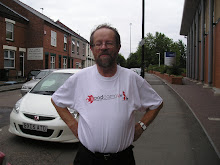 Just to clarify a note I made a couple of posts ago. Luxembourgish is an old language, dating back a thousand years or more. I’d thought that it hadn’t ever been written down properly until the last few years, but that’s a mistake. There were plenty of books in the language in the 19th century alone. But its spelling has been revised, and only as recently as 1976 when a new spelling system was adopted. You can read some Luxembourgish in the street names (Nie Wee has to New Way, surely), but you don’t see it written much around the city. In the suburb we’re staying in, Senningerberg (which is spelt differently on a sign just along the road!) the street names are all Luxembourgish. There are several streets with Gaass as part of the name. I assume it’s something like the English word, Close, though these Gaass aren’t cul-de-sacs. Unfortunately it doesn’t appear in the only Luxembourgeois (see what I mean?) dictionary I could find on the Net.
Just to clarify a note I made a couple of posts ago. Luxembourgish is an old language, dating back a thousand years or more. I’d thought that it hadn’t ever been written down properly until the last few years, but that’s a mistake. There were plenty of books in the language in the 19th century alone. But its spelling has been revised, and only as recently as 1976 when a new spelling system was adopted. You can read some Luxembourgish in the street names (Nie Wee has to New Way, surely), but you don’t see it written much around the city. In the suburb we’re staying in, Senningerberg (which is spelt differently on a sign just along the road!) the street names are all Luxembourgish. There are several streets with Gaass as part of the name. I assume it’s something like the English word, Close, though these Gaass aren’t cul-de-sacs. Unfortunately it doesn’t appear in the only Luxembourgeois (see what I mean?) dictionary I could find on the Net.And something else about the language here: the children are taught in German in primary school, and in French in secondary school. (Not all subjects, but several.) So they don’t just learn these languages; they’re immersed in them. I gather that German got its foothold during the War, when the Germans occupied all sorts of European states. And then French took over after that.
There's a curiosity just along the road: Charly's Gare. A Gare, as I mentioned in the last post, is a railway station (although the airport is also called a Gare!). Charly's Gare is a former railway station that's now a restaurant. But where did the possessive apostrophe come from? The French don't use apostrophes in that way: for them it's always the railway station of the Charly. (I don't think Charly was a person, by the way; more likely the place.) So how come this looks like an English possessive apostrophe?

1 comment:
Love the photo...very staunch !
Post a Comment